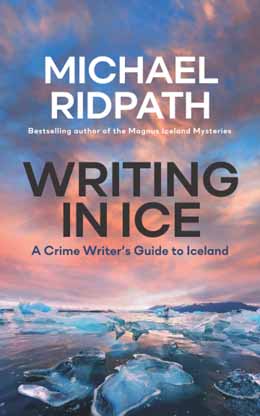With such diverse examples such as Anne Lamott’s Bird By Bird, On Writing by Stephen King and Walter Mosley’s Elements of Fiction, it’s clear that novelists sometimes enjoy experimenting when it comes to releasing a craft book. The act of writing is so personal that honestly no two individuals are ever going to approach it in the same way; that is why these writing guides continue to be released and continue to fascinate. The latest in this line of unusual craft books is Writing in Ice by Michael Ridpath. Subtitled “A Crime Writer’s Guide to Iceland,” that is exactly what this book is – part travelogue, part historical survey, and part sociological study, all sprinkled with writing tips and tricks.
After several successful financial thrillers, Michael Ridpath shifted to a series set in Iceland – a county he knew only the briefest amount about when he started down that path. In Writing in Ice, he tracks that journey, explaining his decision-making process as it relates to his crime fiction series, while also recounting his love affair with this unique locale and its peoples (from the birth of Iceland to present day.)
Ridpath keeps the chapters short and concise – the entire book is under 200 pages – by narrowing his focus, without skipping crucial components.
The travelogue aspect of the volume covers everything from the language to the almost non-existent crime rate. Michael Ridpath devotes nine brief vignettes to his Favorite Places in Iceland – detailing a bit about each location, general directions for getting there, and an accounting of why he finds that particular site/location a must-see. There are brief chapters on the wildlife, the weather, and even the timely topic of Covid-19.
Woven into the history elements are topics going as far back as the advent of The Sagas that recount the history of Iceland in epic fashion. There is a detailed explanation – understandable to any layperson – of the devastating financial crisis (2008-2011) which hit the nation hard, and a recounting of the major volcanic activity that has plagued the island since inception. There are also some fun facts about Elves and Hidden People…and no, they are not the same thing.
In terms of writing advice, Writing in Ice touches on the creation of a lead character that can withstand the stresses of a series and secondary characters and situations that will keep the reader engaged with authenticity. Michael Ridpath also shares tidbits about research, interviewing locals, weaving in mythology, and more.
All in all, Writing in Ice is a delightful read – sure to please fans of Iceland, but also just an interesting accounting of a writer’s life and process for those that find such memoirs engaging. If you haven’t read Michael Ridpath’s Magnus Iceland novels, this book will certainly inspire you to start them immediately. The book is dedicated to a number of other Icelandic writers with whom followers of BOLO Books should already be familiar: Ragnar Jónasson, Yrsa Sigurðardóttir, Lilja Sigurðardóttir, as well as translator extraordinaire, Quentin Bates.
Since I am headed to Iceland Noir this November, this was the perfect primer and just know that other readers will enjoy this book as much as I did.

BUY LINKS: Writing in Ice by Michael Ridpath
